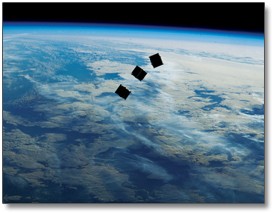Mini Satellite Circles the Earth
By Joe Giacobello
As modern technology becomes more advanced, you've probably noticed that your telephone, computer and other electronic gadgets are gradually becoming smaller and smaller in size. This "shrinking" trend seems to be playing out in the area of space technology, too. On October 4, 2012, NASA launched a tiny cube-shaped satellite into space called "TechEdSat," which measures just 4" (10cm) in length. Equipped with a ham radio transmitter, it will circle in low Earth orbit for several weeks, sending valuable information to NASA engineers and student interns.
Simple Design
Built by San Jose State University students with support from staff at NASA's Ames Research Center, the satellite was put together using only commercial hardware and a highly simplified design. Its mission: to evaluate Space Plug and Play Avionics (SPA), and to perform a communications experiment using a satellite phone network. It will allow the San Jose engineering students to experience a spaceflight project from its inception through its final decommission.
Cost Efficient
Extremely inexpensive to build, the TechEdSat satellite cost less than $30,000 — a far cry from the price tag of a standard satellite, which can range in the hundreds of millions of dollars. "It costs when you send mass to space," said NASA spokeswoman Ann Marie Trotta. "With nanotechnology, the smaller you make things, the cheaper and more efficient it is." A concerted effort among NASA, academia and industry, the TechEdSat mission sets a standard for future projects with small satellites known as CubeSats.
Cubseats
By definition, a CubeSat is a miniaturized space research satellite that generally has a volume of exactly one liter (10cm cube), a mass of no more than 1.33kg, and typically uses commercial, off-the-shelf components. The first CubeSat was launched in June 2003 on a Russian Eurockot, and approximately 75 of them have been placed into orbit as of August 2012. With a simple infrastructure and small size, CubeSats provide an easy, cost effective means of getting a payload into orbit. Most carry one or two scientific instruments as their primary mission payload. A fast-growing technology, CubeSats are small devices that can enhance space science and exploration in a very big way.
Classroom Discussion
- List five benefits/uses of satellites
- List five advantages that a miniature satellite offers over conventional ones
